A Complete Guide to Marching Band Instruments

Marching Band Instruments
The vibrant and dynamic performances of marching bands are made possible by the essential contributions of marching band instruments.
These instruments play a crucial role in creating the unique and harmonious sounds that define the marching band experience.
From brass and woodwinds to percussion instruments, the marching band ensemble encompasses a diverse array of musical tools.
Each instrument, carefully chosen for its distinctive qualities, adds a layer of complexity to the overall sonic landscape of the marching band.
Whether it’s the powerful resonance of brass instruments or the melodic richness of woodwinds, each element works in harmony to captivate audiences.
These contributions, along with the rhythmic beats of percussion, make marching band performances a celebration of music and unity.
In this article, we explore the diverse types of instruments found in a typical marching band by examining the various sections to which these instruments belong.
By the end, you will gain an understanding of the unique roles each instrument plays in creating harmony and rhythm for all to enjoy.
Marching Band
A marching band comprises instrumental musicians who play their instruments while marching, typically for the purpose of entertainment or competition.
It’s important to note that a marching band is more than just playing instruments; it involves precise, synchronized movement.
Band members practice intricate formations, creating shapes and patterns as they march.
This synchronized movement adds a visual dimension to the music, offering a mesmerizing show for the audience.
Marching bands hold significant cultural value in America, often appearing at sporting events, parades, and special occasions.
These bands feature a variety of instruments, including brass, woodwind, and percussion.
The following section will discuss further details about marching band instruments.
What are the Marching Band Instruments?
Marching Band Instruments are a collection of musical tools that marching bands use when they perform while marching, either for competitions or entertainment.
The size and makeup of a marching band can be quite different. Some bands have just a few members, while others have over 500.
Because of this, the types of instruments used in marching bands can vary a lot between different groups.
Despite these differences, marching bands generally include various instruments that work together to make a musical performance that is both harmonious and rhythmic.
Marching band instruments typically fall into three categories: brass, woodwind, and percussion.
Now, let’s explore some common marching band instruments:
Brass Marching Band Instruments
Let’s begin with the brass instruments, a vital and dynamic section that adds strength and resonance to the overall sound of the marching band.
Indeed, the brass marching band instruments provide the power, delivering a strong and commanding presence in the ensemble’s sound.
In a marching band, the brass section typically features trumpets or cornets, French horns, alto horns or mellophones, tenor trombones, baritone horns or euphoniums, and tubas or sousaphones.
Note that parade organizers occasionally feature euphoniums, and they are more commonly utilized in the United Kingdom. However, for competitive marching band purposes, they do not consider them the most suitable choice.
At times, E♭ soprano cornets may be introduced to complement or replace the high woodwinds, and the mellophone might take the place of the French horn.
In more extensive bands, you might find the inclusion of bass trombones and flugelhorns.
These shiny instruments, crafted from brass, produce bold, brassy sounds when players blow into them, audible even from a distance.
Imagine the thrill of leading a parade with the triumphant notes of a trumpet!
For marching performances, instrument makers have developed special versions of the lower brass. They wrap these instruments in a way that directs the bell toward the audience.
Going a step further, some bands modify their instruments, exchanging items like slide trombones for alternatives such as valved trombones or marching baritone horns.
This adjustment ensures the band produces the perfect sound as they march in formation.
Generally, brass instruments are the loudest and most recognizable instruments in a marching band.
They are made of metal and are played by blowing air through a mouthpiece that causes the instrument to vibrate.
Some common brass instruments in a marching band include:
- Cornet
- Trumpet
- Trombone
- Bass trombone
- Euphoniums
- French horn
- Mellophone
- Tuba
- Sousaphone Tuba
Cornet
The cornet is one of the brass instruments commonly used in marching bands.
It stands as one of the cornerstone instruments in the marching band’s instrumentation, contributing to its unique and powerful sound.
The cornet is a member of the trumpet family, sharing a similar construction and playing technique. It consists of a conical bore, three piston valves, and a mouthpiece.
It is similar to the trumpet but has a more compact shape and a mellower, slightly conical bore.

The cornet produces a bright and clear sound, making it a versatile instrument for various musical genres, including marching band music.
This distinctive timbre makes it well-suited for both solo passages and harmonizing with other instruments.
Its ability to soar above the ensemble and deliver both melody and harmony makes it an indispensable instrument in the marching band tradition.
The cornet’s bright, piercing sound adds excitement and energy to marching band performances, captivating audiences and leaving a lasting impression.
Marching band performers often carry their cornets in a specific manner, either using a traditional carry or a side carry, depending on the band’s preference and style.
The cornet player contributes to the band’s visual appeal with coordinated movements and precise playing, enhancing the overall marching band performance.
Trumpet
The trumpet is a prominent brass instrument widely used in marching bands.
It features a distinctive cylindrical bore, a flared bell, and three valves that the player uses to produce different pitches.
The trumpet’s versatility allows it to handle a wide range of musical styles, making it a fundamental element in creating a dynamic and engaging marching band sound.
In a marching band context, trumpets play a crucial role in delivering bold and melodic lines, adding a vibrant and triumphant quality to the overall ensemble.

This brass horn stands out as the soprano voice of the marching band instruments.
The trumpet is widely known for its characteristic of being both loud and lyrical, making it a special instrument in the band.
Its bright and powerful sound that can cut through the sound of other instruments makes it a key component of the brass section in marching bands.
When played, the trumpet can produce loud, resonant tones and also create beautiful melodies.
Additionally, when teamed up with low brass instruments, the trumpet adds its voice to make the marching band’s harmonies beautiful.
Marching bands commonly showcase several trumpets, often ranging from 6 to 8 or even more.
Finally, their lightweight design makes trumpets a favored option for members of marching bands due to their ease of carrying.
Trombone
The trombone is another versatile brass instrument commonly found in marching bands.
It features a long, cylindrical tube with a flared bell and a telescoping slide mechanism.
This slide allows the player to change the pitch by altering the length of the tube, producing a smooth and distinctive glissando effect.
In a marching band setting, trombones play a crucial role in the brass section, contributing rich and resonant tones to the overall sound.
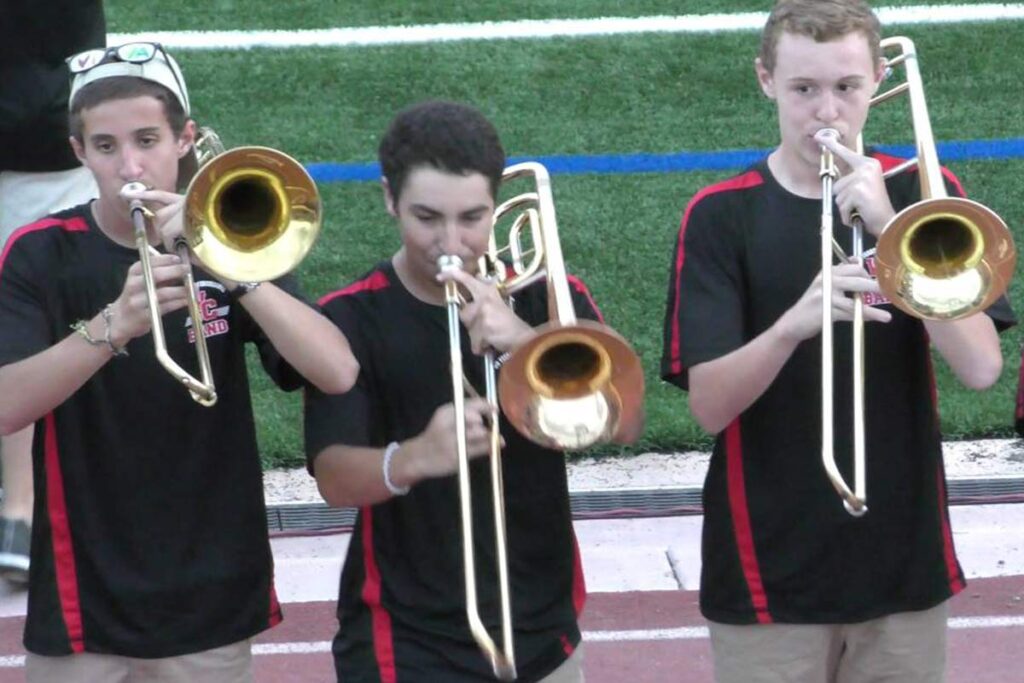
The trombone’s unique ability to smoothly glide between notes adds a dynamic and expressive element to the ensemble’s performance.
Its adaptability makes it well-suited for various musical genres, ensuring a vibrant and engaging sound in the marching band repertoire.
Despite its unique shape, which can make it a bit challenging to carry while marching, the trombone’s distinctive sound is well worth the extra effort!
In marching bands, you’ll usually spot multiple trombones, ranging from 2 or 3 to more than 15!
These trombones are often used to deliver powerful, bold melodies and harmonies.
Whether providing a solid bassline or soaring above the ensemble, the trombone remains a key component of the marching band’s brass section.
Bass Trombone
The bass trombone is a specialized instrument within the trombone family, known for its lower pitch and extended range.
In marching bands, the bass trombone plays a unique role, contributing to the overall depth and richness of the brass section.
Unlike the standard tenor trombone, the bass trombone features additional tubing and a larger bell, allowing it to produce lower frequencies.
This characteristic makes it well-suited for providing a solid foundation for the brass ensemble, particularly in the lower register.
The bass trombonist employs a larger mouthpiece, which, combined with the instrument’s design, produces a distinct and powerful sound.
This instrument often takes on a supporting role, reinforcing the lower brass and enhancing the overall tonal balance of the marching band.
In terms of visual presentation, the player holds the bass trombone similarly to the tenor trombone, with the instrument facing forward.
The commanding presence of the bass trombone, both in sound and appearance, contributes to the overall impact and effectiveness of the marching band’s performance.
French Horn
The French horn is a brass instrument that adds a unique and melodious quality to the sound of a marching band.
Its distinctive coiled shape and flared bell make it easily recognizable.
In a marching band, the French horn is part of the brass section and contributes to the harmonic richness of the ensemble.

It has a mellow and warm tone, providing a contrast to the brighter sounds of trumpets and trombones.
The French horn often plays melodic and supporting roles, adding depth to the overall musical texture.
French horns are typically carried with the bell facing backward, which directs the sound towards the audience.
Basically, the mellophone is often used in marching bands, particularly in corps-style bands, as a substitute for the French horn. We will discuss the mellophone in more detail in the next section.
Technically, there’s nothing preventing people from using the French horn in a marching band; the military has been doing it for a century now.
However, when it comes to the corps style of a marching band, there are definitely advantages to using the mellophone.
The most obvious, of course, is the bell. The French horn has a bell that points behind the player. When you’re outside and the audience is in front of you, they won’t hear you well.
In contrast, the mellophone directs its sound toward the audience as a bell-front instrument, making it more audible.
Mellophone
The mellophone is a brass instrument commonly employed in marching bands to add a bright and powerful sound to the ensemble.
Resembling a fusion of a French horn and a trumpet, the mellophone essentially features a French horn with a forward-facing bell, giving it a distinctive appearance.
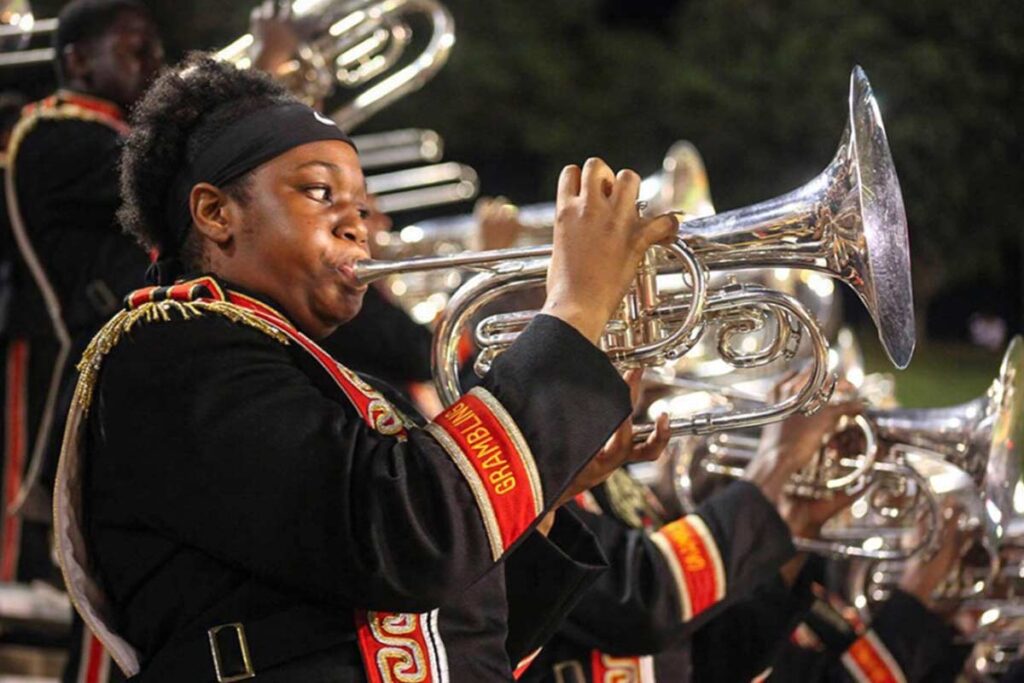
This design enables more directional sound projection, making it particularly suitable for outdoor performances.
The mellophone’s efficient sound projection while on the move has earned it the nickname “marching French Horn.”
In marching bands, the mellophone often serves as a substitute for the French horn.
The mellophone produces its clear and penetrating tone by being played with a mouthpiece, similar to other brass instruments.
Despite their visual similarity to trumpets, mellophones have a larger bell, resulting in a mellower sound and justifying the instrument’s name.
With its smooth and mellow tone, the mellophone stands out, distinguished by its larger bell compared to the trumpet.
The musician holds the instrument with both hands and produces different pitches by using a combination of valve fingerings.
Tuba
The tuba is the largest brass instrument, playing a crucial role in providing the low, deep, and resonant foundation of the marching band’s sound.
Tuba players use a mouthpiece to produce sound, manipulating valves to change the pitch.
Known for its rich, deep, and sonorous tone, the tuba is an essential component of the brass section.
In a marching band, it serves as the bass voice, contributing to overall balance and harmony, often considered the “backbone” of the band, and providing foundational support for other instruments.
Besides delivering fundamental bass notes, the tuba plays a supportive role in creating rhythmic patterns and emphasizing musical phrases.
Most marching bands use multiple tubas, typically around 3 to 4, or even more depending on the band’s size.
Due to its size and the deep tones it produces, the tuba is often positioned at the back of the band.
Despite its large size and weight, carrying the tuba while marching can be challenging, as student or beginner versions stand almost 3 feet tall and weigh around 6 kg (13–14 pounds).
However, a marching tuba is played horizontally with the bell facing forward, rather than being held vertically. The design is lightweight and considers the player’s requirement to face forward during marching.

Tuba players in a marching band need strength and endurance to carry and play the instrument effectively during performances, but they are typically among the strongest and most enthusiastic members of the band.
Sousaphone
The sousaphone, a brass instrument belonging to the tuba family, was specifically crafted for marching bands. It was named after the American instrument maker and bandleader John Philip Sousa.
One of its prominent features is its marching configuration, designed with the marching band in mind.
Worn over the player’s shoulder using a harness, the sousaphone has a distinctive shape, including a large, coiled metal tube that wraps around the player’s body.
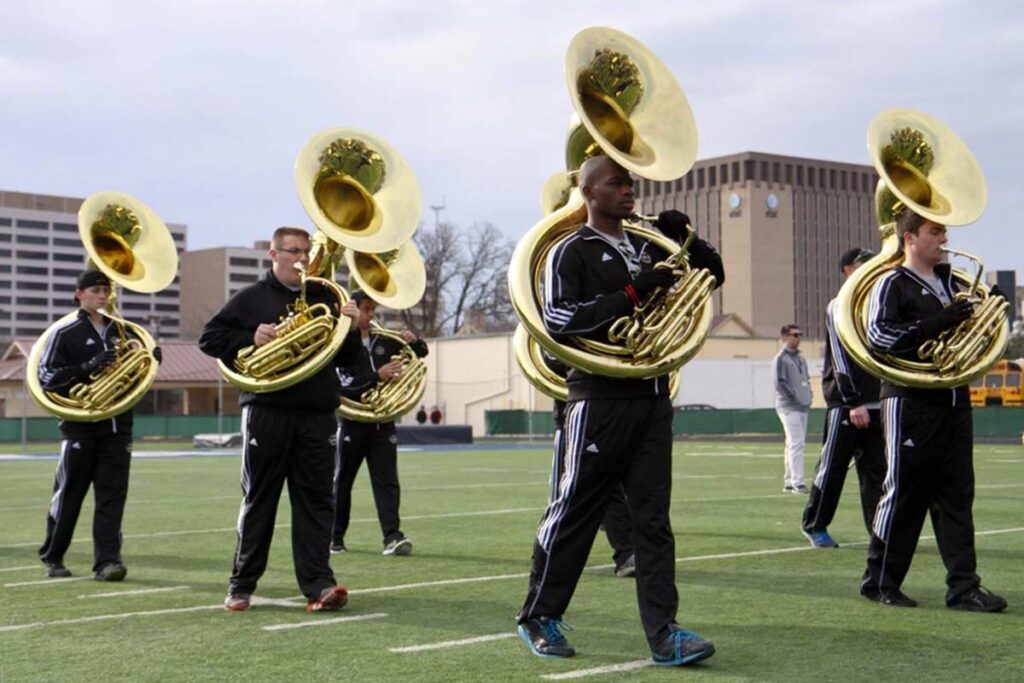
This design facilitates mobility and comfort while marching while shouldering the instrument’s weight.
As a consequence, the sousaphone has become the favored choice as the bass brass instrument in the majority of marching bands.
Recognized for its wide bell facing forward and upward, the instrument effectively projects sound in outdoor settings, with the bell typically resting on the player’s left shoulder.
Constructed primarily from brass, often with a lacquer or silver-plated finish, like other brass instruments, the sousaphone acquires its characteristic warm and resonant sound.
With a broad tonal range, it serves as the foundation of the brass section in a marching band, offering low-end and bass support to the overall ensemble.
In the marching band context, the sousaphone plays a pivotal role in establishing the rhythmic and harmonic foundation, frequently carrying the bassline in the ensemble and complementing higher-pitched brass and woodwind instruments.
The sousaphone’s powerful sound is instrumental in projecting low frequencies outdoors, making it a vital component in parades, halftime shows, and various marching band performances.
While its primary use is in marching bands, the sousaphone can also be found in concert bands and occasionally in jazz ensembles.
Its versatility and unique design make it a distinctive and important instrument in various musical settings.
Percussion Marching Band Instruments
Now, let’s dive into the heartbeat of the marching band—percussion instruments.
Marching percussion, often known as the drumline, battery, or back battery, plays a crucial role in keeping the tempo for a band.
It includes instruments like snare drums, tenor drums, bass drums, and cymbals, all specially adapted for outdoor use, allowing the band to move around.
Some ensembles also use marching versions of the glockenspiel (bells), xylophone, and marimba, though these are less common.
Drums, cymbals, and xylophones create rhythmic beats that keep everyone in step.
In the past, the percussion section used timpani with manual controls that could be mounted for specific effects. This rich variety of instruments helps create the energetic and dynamic sounds you hear during a marching band performance.
The energetic beats of percussion instruments add a lively and dynamic element to the marching band’s performance.
They provide the rhythm and beat for the marching band. Some common percussion instruments in a marching band include:
- Bass drum
- Cymbals
- Glockenspiel
- Snare drum
- Tenor drum
- Wood Blocks
- Timpani
Bass Drum
The bass drum stands out as a crucial part of the percussion team in a marching band.
As the biggest and lowest drum in the family, it plays a key role in creating the band’s powerful and rhythmic foundation.
In marching bands, these drums can be huge, with diameters exceeding 2 1/2 feet and weighing around 35 pounds, not including the 4 to 8 pounds added by the harness.
Worn using a harness, the bass drum is placed in front of the musician, allowing them to move easily during performances.
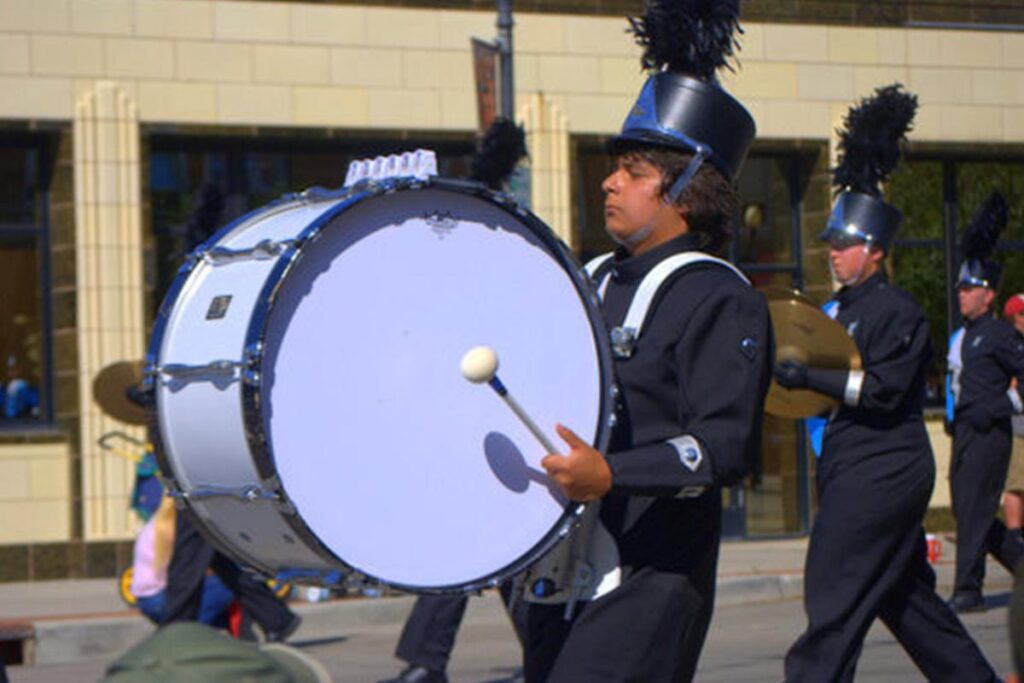
Using a mallet, the drummer strikes the large cylindrical drum head on either side to produce its deep and resonant tones.
In a marching band, the bass drum plays a crucial role in maintaining the tempo and providing a solid beat for the entire ensemble.
It’s the largest drum in the band, producing deep, resonant tones that add a powerful and rhythmic foundation to the band’s symphonic sound.
The size of the drumhead contributes to the instrument’s ability to produce lower frequencies, giving the bass drum its distinctive booming and reverberating sound.
The bass drum often works in coordination with other percussion instruments, such as the snare drum and tenor drums, to create intricate and dynamic rhythmic patterns.
It serves as both an auditory powerhouse and a visual element in the performance with its commanding presence and synchronized movements within the percussion section.
Cymbals
Cymbals are an integral part of the percussion section in a marching band, contributing both to the auditory and visual aspects of the ensemble’s performance.
These metallic, circular instruments are crafted from various alloys, such as brass or bronze, and come in a range of sizes to produce different tones and effects.
Cymbals serve as a great example of a percussion instrument that doesn’t have a specific pitch (non-pitched), making them untuned.
The ones you see in marching bands are called crash cymbals, and their sizes can vary from 16 to 22 inches in diameter.

In terms of sound production, cymbals are clashed together, creating a bright and resonant sound.
The intensity of the clash, along with variations in technique, allows for a wide range of expressive possibilities.
Cymbals add accents, crashes, and shimmering undertones to the overall sound of the marching band.
One distinctive feature of cymbals is their visual impact.
Mounted on stands and played by dedicated cymbal players, these instruments provide auditory highlights. They also contribute to the dynamic movements and visual appeal of the marching band.
Cymbal players often execute precise and synchronized patterns, enhancing the overall choreography of the performance.
In the marching band context, cymbals work in coordination with other percussion instruments to create rhythmic textures for the band.
They also add emphasis to musical phrases and contribute to the overall energy and excitement of the ensemble’s presentation.
Above all, cymbals play a crucial role in shaping the sonic landscape of a marching band performance by delivering sharp accents and, at times, providing a sustained wash of sound.
Glockenspiel
The glockenspiel, which means “set of bells” in German, is a tuned, bright, and melodic percussion instrument that is occasionally featured in marching bands.
It belongs to the metallophone family and consists of tuned metal bars arranged in the fashion of a keyboard.
It resembles a xylophone, but its bars are crafted from steel instead of wood and are organized into two sections.
Each bar represents a specific pitch, and the instrument is played by striking the bars with mallets.

In contrast to the typical glockenspiel, those used in marching bands have a distinct appearance and go by the names Marching Glockenspiel or Bell Lyres.
In a marching band context, the glockenspiel is often mounted on a lyre or a harness.
Typically, they take on a lyre-like shape and are held upright, making them more convenient to play while on the move.
Its bright and crystalline tones cut through the ensemble’s sound, adding a distinctive high-pitched element to the overall musical texture.
While not as common as some other marching band instruments, the glockenspiel is valued for its ability to contribute clear and piercing notes that enhance the musical arrangements.
Its presence is particularly notable in sections where a bright and sparkling sound is desired, providing a unique timbre to the band’s performance.
The glockenspiel’s visual appeal, with its gleaming metal bars, also adds to the overall aesthetics of the marching band.
Snare Drum
The snare drum holds a crucial role as a fundamental and dynamic percussion instrument in the marching band.
It is a relatively small drum with a set of tightly stretched snares (metal wires) across the bottom head, giving it a distinctively sharp and crisp sound.
The name “snare” comes from the strips of wire or gut attached underneath the drum. Typically made of metal, these strips vibrate when the drum is hit, creating a distinctive rattling sound.
In the marching band context, the snare drum is typically worn using a harness, allowing the drummer to move freely while playing.

It’s a small, cylindrical drum played with two sticks.
The drummers, known as snare drummers, play intricate and rhythmic patterns that contribute to the overall cadence and energy of the marching band.
This drum not only sets the beat for the music but also adds exciting accents and special effects like drum rolls.
The snare drum is a versatile marching band instrument capable of producing a wide range of tones, from staccato and sharp accents to softer and more muted sounds.
Its prominent position in the drumline makes it a key element in creating the overall musical and rhythmic texture of the marching band performance.
Tenor Drums
The tenor drums play a crucial role in the percussion section of a marching band. It’s a mid-sized drum, larger than a snare drum but smaller than a bass drum.
The higher-pitched members of the drumline, known as multi-tenors or toms, are considered the most challenging in the battery.
In the marching band setting, these tenor drums, sometimes called quads, are typically played in sets of two to six drums.

The standard configuration consists of four main drums and two accent drums, though this can vary based on the band’s size.
The tenor drum is often carried in a harness, allowing the musician to move and play simultaneously during a marching band performance.
The distinctive feature of the tenor drum is its arrangement of differently sized drums mounted together, forming a set known as a “tenor drum group” or “tenor line.”
Each drum in the set produces a unique pitch, creating a melodic element within the percussion section.
In a marching band, the tenor drum adds vibrancy, depth, and complexity to the overall rhythmic patterns.
The player uses mallets or drumsticks to strike the drumheads, producing a sharp and resonant sound.
The tenor drum player often performs intricate and visually engaging stick tricks while playing, contributing to the dynamic and entertaining nature of the marching band performance.
The tenor drum’s role extends beyond providing rhythm; it contributes musical nuances and visual flair, making it an integral part of the marching band’s percussion ensemble.
Wood Blocks
Wood blocks are percussion instruments commonly found in marching bands, adding a unique and rhythmic element to the ensemble’s sound.
Typically crafted from wood, primarily teak, and available in various sizes, these instruments produce different pitches.

Wood blocks contribute a vibrant rhythmic element to the overall sound of marching bands.
In a marching band context, wood blocks are often mounted on a stand or played handheld by a musician.
The wood block produces sound when struck with a mallet or drumstick, creating sharp and resonant tones.
These distinctive sounds contribute to the overall texture and dynamic range of the percussion section.
Wood blocks are versatile instruments that can be employed to enhance the rhythmic patterns and accents in the music performed by the marching band.
Drumline in Action
The Bluecoats Drumline runs through their finale, “Bryant’s Concerto,” as part of their warm-up before the performance in Chester, PA.
The display of pure talent is evident in the seamless coordination between the snare players, accompanied by the impressive support of the quads and bass.
The tenors entered simultaneously, maintaining precision throughout the line without a single deviation, resulting in a flawlessly executed performance!
Woodwind Marching Band Instruments
Next up are the woodwind instruments, such as clarinets and saxophones. Made of wood or metal, these instruments produce rich, melodious tones.
While the brass instruments contribute power, the woodwinds provide a foundational core to the overall sound.
In some bands, you might not find all the woodwind instruments. However, it’s not unusual to spot piccolos, flutes, B♭ clarinets, alto saxophones, and tenor saxophones (though note that woodwinds aren’t used in drum corps).
While E♭ clarinets, alto clarinets, bass clarinets, and soprano and baritone saxophones are not as common, you can still find them in some marching bands.
However, you’ll rarely see double-reed instruments like bassoons and oboes on the field because they could easily get damaged.
Essentially, it’s tricky to march with a double reed exposed, and they’re also quite sensitive to the weather.
Some common woodwind instruments in a marching band include the following:
- Piccolo
- Flute
- Clarinet
- Bass clarinet
- Saxophone
- Alto saxophone
- Baritone saxophone
Piccolo
The piccolo is a small, high-pitched member of the woodwind family and is a common instrument in marching bands.
It is typically half the size of a standard flute and produces notes one octave higher than the flute.
The piccolo’s design includes a cylindrical tube with a conical head and a complex system of keys and pads. It is usually made of metal, wood, or plastic.
The piccolo produces a bright, piercing sound that can be heard over the louder instruments in a marching band.
Its high register makes it well-suited for providing melodies and accents and adding brilliance to the overall ensemble sound.
In a marching band, the piccolo plays a crucial role in providing high, clear tones that cut through the ensemble.

It is often used to carry the melody in certain sections of a piece, add ornamentation, or provide dynamic contrast.
The piccolo contributes to the overall balance and texture of the band.
Its compact size, high pitch, and versatility make it a valuable component of the woodwind section in both traditional and contemporary marching band settings.
Playing the piccolo requires a specific embouchure and breath control due to its smaller size and higher pitch.
Musicians who play the piccolo often develop a level of proficiency in these aspects to produce a clear and resonant tone.
Like other woodwind instruments, the piccolo can be played while marching.
Marching piccolos are designed for easy handling and playability while on the move.
Flute
The flute, typically constructed of metal, is a slender and cylindrical instrument featuring various keys and a distinctive, small, circular mouthpiece.
Belonging to the woodwind family, it plays a crucial role in shaping the vibrant and melodic soundscape of a marching band.
Flute players actively create music by blowing air across the embouchure hole and skillfully manipulating the keys to produce an array of pitches.

Renowned for its beautiful, bright, high-pitched, and clear tones, the flute significantly contributes to the overall richness of the marching band’s sound.
Within the marching band setting, flutes hold significant value for their capability to carry melodies and introduce a layer of complexity to the musical arrangement.
The flute’s agility and versatility render it well-suited for various musical genres performed by marching bands.
As an integral component of the marching band’s instrumentation, the flute not only brings auditory excellence but also imparts visual grace to the ensemble’s dynamic performances.
In a marching band, you will typically encounter 2 or 3 flutes, although some bands may boast a considerably larger number!
Clarinet
This is another versatile woodwind instrument that holds a significant place in the lineup of a marching band.
Crafted from wood or synthetic materials, the clarinet features a slender, cylindrical shape with a flared bell at one end.
Clarinetists produce music by blowing air through a single reed attached to the mouthpiece.

The instrument’s keys and fingerings allow for a wide range of pitches and tones.
The clarinet boasts one of the broadest pitch ranges within the woodwind family.
While its lower notes produce a dark and honeyed sound, the higher notes resonate with vividness and brightness.
Recognized for its distinctive sound, the clarinet adds depth and character to the ensemble’s musical performance.
In the context of a marching band, the clarinet often contributes to harmonies, provides melodic elements, and enriches the overall timbre of the woodwind section.
Whether performing intricate passages or supporting the band’s collective sound, the clarinet plays a vital role in creating a balanced and captivating musical experience.
The visual impact of clarinetists marching in formation enhances the aesthetic appeal of the woodwind section, making the clarinet both an auditory and visual asset to the marching band.
Bass Clarinet
The bass clarinet, a distinctive member of the clarinet family, is similar in structure to the standard clarinet but larger and pitched lower, extending the range of the woodwind section.
Musicians play the bass clarinet using a single reed and a mouthpiece, much like its smaller counterpart.
Designed with its curved shape and additional tubing, the bass clarinet produces lower frequencies, contributing a rich and robust quality to the band’s overall musical composition.

In the context of a marching band, the bass clarinet’s unique timbre enhances the depth of the woodwind section, though it is not as loud as the brass.
Generally, bass clarinets regularly perform in orchestras, wind ensembles, and concert bands, and occasionally in marching bands.
However, the bass clarinet typically lacks the projection on the open field seen in other bass instruments, contributing to its infrequent use in marching bands.
Despite this, some include it as part of their marching band instrument lineup.
Typically, a marching band featuring the bass clarinet will have one or two of these instruments.
Saxophone
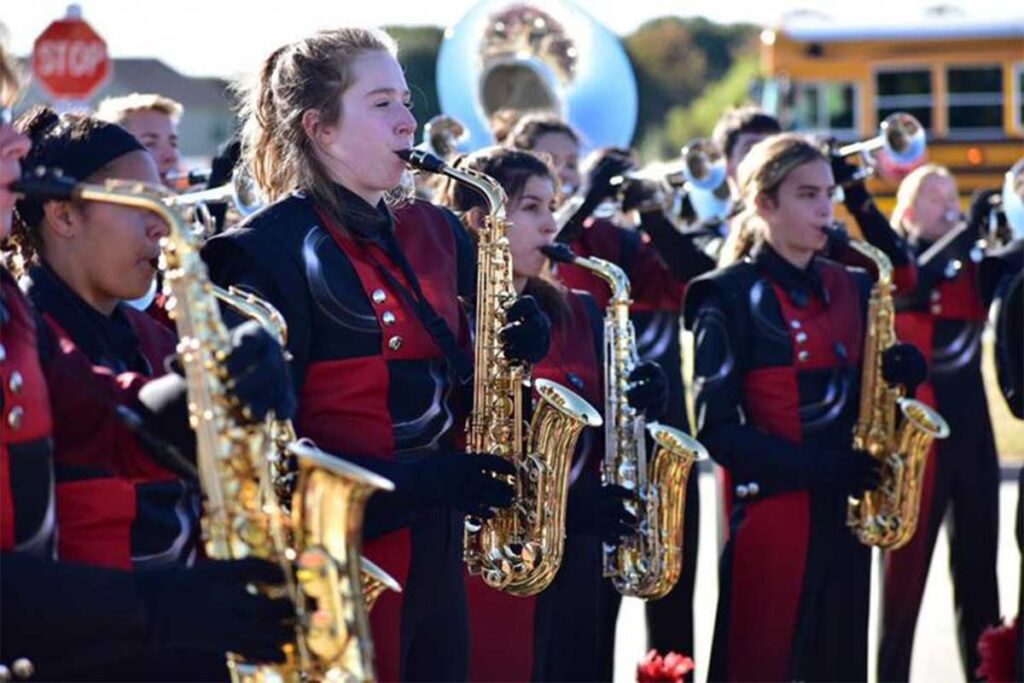
The saxophone stands as a valuable asset in the woodwind section of a marching band.
Adolphe Sax invented it in the 1840s, giving it a distinct conical shape and a single-reed mouthpiece, akin to the clarinet.
Saxophonists, the players of this remarkable instrument, use a combination of keys and fingerings to create diverse pitches, producing a vibrant and melodic sound.
This versatile single-reed instrument allows for a broad range of musical expression, making it a favored choice across various genres, including marching band music.
In a typical marching band, saxophones come in different sizes, each with its own unique pitch.
The most commonly used are the alto saxophone, followed by the tenor saxophone, and occasionally the soprano saxophone.
Larger marching bands might also feature the baritone saxophone, known for its low and resonant tones.
Whether playing melodic lines and harmonies or providing counterpoint to other sections, the saxophone adds a dynamic and expressive quality to the overall marching band performance.
Its distinct timbre enhances the depth and richness of the band’s sound.
Saxophones in marching bands are similar to those played in concert ensembles.
However, because players perform outdoors in various weather conditions, they need to carefully choose instruments suitable for outdoor settings.
Alto Saxophone

In a marching band, the alto saxophone significantly stands out as the most commonly used member among the saxophone family in the woodwind section.
Known for its versatility and distinctive sound, the alto saxophone’s medium size and range make it a favored choice for various musical styles.
It plays a crucial role by adding melodic and harmonic elements to the overall ensemble.
Producing bright and expressive tones, the alto saxophone stands out in solo performances and blends seamlessly with other woodwind instruments.
While alto saxophones can play a wide range of pitches, they usually fill the middle range of the band.
Most commonly, alto saxes match mellophone parts, but they can also play alongside lower clarinets, trumpets, or other instruments in that range.
However, they cannot reach the high register of the flute or the low range of trombones, baritones, euphoniums, or tubas.
Frequently featured in melodic lines, harmonies, and improvisational sections, the alto saxophone significantly contributes to the overall musical texture of the marching band.
Tenor Saxophone
Tenor and baritone saxophones, although less common, can occasionally be spotted in marching bands.
The most prevalent type of saxophone found in these bands, however, is the alto saxophone.
Following the alto saxophone, the tenor saxophone is the next most frequently used.
Larger than the alto saxophone, it can play in a lower range, falling between the higher-pitched alto and the lower-pitched baritone saxophones.
Tenor saxophones are known to match trombones, baritones, and euphoniums.
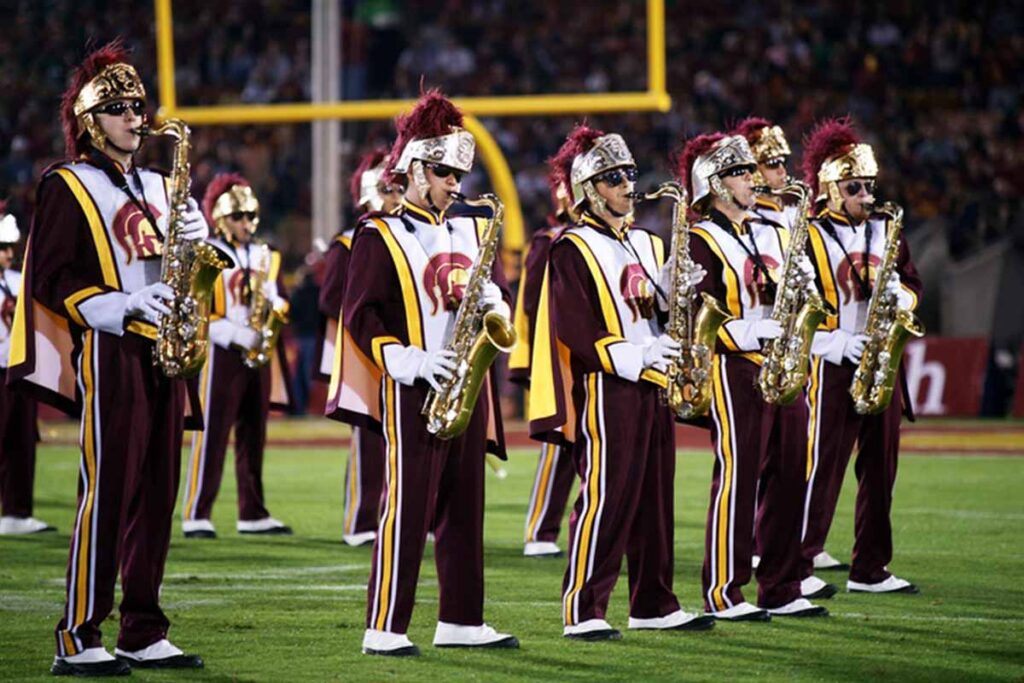
They are versatile instruments with the flexibility to handle low parts while maintaining the agility needed for faster woodwind sections.
Tenor saxophones often match the pitch of the mellophone and may harmonize with other mid-range instruments, providing interesting and varied musical parts.
Baritone Saxophone

This is the largest saxophones seen in marching bands, are not present in every band due to their size and weight.
Typically heavier than other saxophones, they can produce very low sounds.
While most marching bands rely on low brass instruments for this range, some directors turn to the baritone saxophone when faced with challenges in filling low brass positions.
This low-pitched instrument contributes deep, resonant tones that form the foundation of the ensemble’s sound.
Recognizable by its large, looping shape and single-reed mouthpiece, the baritone saxophone produces rich and expressive low-frequency tones.
Described as robust and mellow, its sound is crucial for achieving a balanced and full-bodied ensemble.
Baritone saxophones often match the pitch of the tubas or sousaphones, enhancing the depth of the low brass section.
Both the tenor and baritone saxophones bring distinct sounds and roles to the marching band, contributing to the overall balance and richness of the ensemble’s sonic landscape.
As essential components of the woodwind section, they work harmoniously with other instruments, creating a dynamic and engaging musical experience when added to the ensemble.
Final Note
Whether or not you’re a marching band enthusiast, it’s impossible to ignore their significance in American culture.
The marching band instruments come together like a magical symphony, creating an unforgettable experience for everyone involved—both the performers and the spectators.
It’s a musical journey and adventure you wouldn’t want to miss for anything!
So, the next time you catch a parade or watch a football game featuring a marching band, allow yourself a moment to appreciate the unique sounds these instruments produce.
Also, observe how each section collaborates not only to create a great auditory experience but also a visually stunning one!
From the powerful notes of brass instruments to the rhythmic beats of percussion, each element contributes significantly to transforming marching band performances into a celebration of music and unity.
Moreover, whenever you witness a marching band in action, keep your eyes peeled for any of the instruments we’ve discussed above.
If you are mindful of the sounds, you might distinguish the melodic trumpet from the deep bass of a tuba.
Having done that, take a moment to appreciate the skill and artistry behind each instrument.
At Phamox Music, we go all out for exactness and honesty. For this purpose, if by any means you found any possible glitch, be it factual, editorial, or something that we need to update, kindly contact us.
If you find the information provided in this post “Marching Band Instruments” interesting and helpful, kindly share it with someone you know that might need it.







